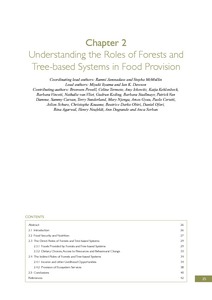Resource information
Forests and other tree-based systems such as agroforestry contribute to food and nutritional security in myriad ways. Directly, trees provide a variety of healthy foods including fruits, leafy vegetables, nuts, seeds and edible oils that can diversify diets and address seasonal food and nutritional gaps. Forests are also sources of a wider range of edible plants and fungi, as well as bushmeat, fish and insects. Treebased systems also support the provision of fodder for meat and dairy animals, of “green fertiliser” to support crop production and of woodfuel, crucial in many communities for cooking food. Indirectly, forests and tree-based systems are a source of income to support communities to purchase foods and they also provide environmental services that support crop production. There are, however, complexities in quantifying the relative benefits and costs of tree-based systems in food provision. These complexities mean that the roles of tree-based systems are often not well understood. A greater understanding focuses on systematic methods for characterising effects across different landscapes and on key indicators,
such as dietary diversity measures. This chapter provides a number of case studies to highlight the relevance of forests and tree-based systems for food security and nutrition, and indicates where there is a need to further quantify the roles of these systems, allowing proper integration of their contribution
into national and international developmental policies.


